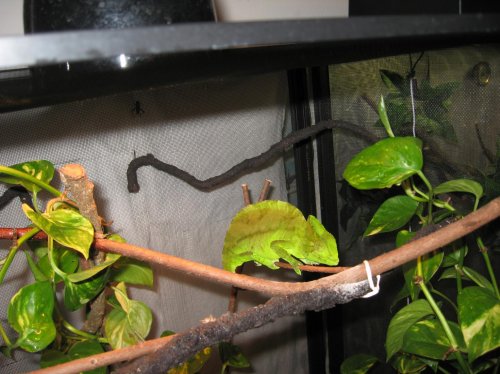I have lost due to sickness two of four Crested Chams. In the first pair both were sickly and the male wasted and died at 1 week The female is doing much better but was lethargic for the first week or so. The second pair was even worse the male died this morning after only 3 days. The second female is not feeding but at least drinks water from a drip.
Typically, when they arrive , they look pretty healthy and eat a few crickets. Next thing I know , they look stressed and stop eating and become skinny slow and lethargic . Later they will seem to not want to drink and soon after they die. Maybe its something in the crickets passed on to the host that makes them sick. Both males have died and seemed very weak and delicate. Both females are currently still alive but not exactly in great condition IMHO. Please respond to the info here if you have anything of interest. Thanks!
Origin: WC
Housing: 30x30x18 screen cage
Hydration: 2 pints of drip plus 2x mist per day / humidity 60 % (humidifier active in their room)
Feeding: crickets and waxworms
Lighting: 50 watt incandescent 5.0 UVB bulb plus 12 inch flourescent UVB
bulb
Temps: 75 to 80 in day / - Daytime basking 80 - cage lower area is 75 / Nightime 72 to 65 .
Typically, when they arrive , they look pretty healthy and eat a few crickets. Next thing I know , they look stressed and stop eating and become skinny slow and lethargic . Later they will seem to not want to drink and soon after they die. Maybe its something in the crickets passed on to the host that makes them sick. Both males have died and seemed very weak and delicate. Both females are currently still alive but not exactly in great condition IMHO. Please respond to the info here if you have anything of interest. Thanks!
Origin: WC
Housing: 30x30x18 screen cage
Hydration: 2 pints of drip plus 2x mist per day / humidity 60 % (humidifier active in their room)
Feeding: crickets and waxworms
Lighting: 50 watt incandescent 5.0 UVB bulb plus 12 inch flourescent UVB
bulb
Temps: 75 to 80 in day / - Daytime basking 80 - cage lower area is 75 / Nightime 72 to 65 .





